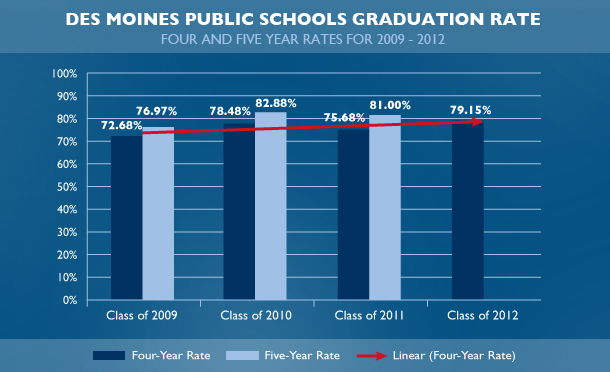DMPS Sees 3.5 Percent Increase in Graduation Rate for Class of 2012
 The Iowa Department of Education today released data on the four-year graduation rate for the Class of 2012 and the five-year rate for the Class of 2011.
The Iowa Department of Education today released data on the four-year graduation rate for the Class of 2012 and the five-year rate for the Class of 2011.
The Class of 2012 at Des Moines Public Schools had a graduation rate of 79.15%, an increase of nearly 3.5% over the previous year and the highest since Iowa began using its current graduation rate formula in 2009.
Statewide figures show an overall increase in the percentage of Iowa high school students who completed high school in four years, with a statewide graduation rate of 89.26% for 2012 compared to 88.3% for 2011. For Des Moines Public Schools, the graduation rate for the Class of 2012 was 79.15%, up from 75.68% for the Class of 2011.
There was a slight decrease in the state’s five-year graduation rate, which was 91.4% for the Class of 2011 compared to 91.8% for the Class of 2010. Des Moines Public Schools also saw a slight decline: 81% for the Class of 2011 compared to 82.88% for the Class of 2010.
This is the fourth year that Iowa graduation rates have been calculated using a formula established by the U.S. Department of Education. Unique student identification numbers are assigned to ninth-grade students, allowing school districts to account for all students as they move through high school. At the state level, the method helps determine when a student graduates, even if the student has moved to a different district in Iowa during high school.
The graduation rate for Des Moines has increased nearly 7 percent since the State of Iowa first started using this formula for the Class of 2009. In addition, the graduation rate is higher today than in 2009 for every student demographic group in Des Moines, with the largest gains among ELL students (+18%), Hispanics (+14%), and males (+9.2%).
The following tables show the four-year graduation rate over the past four years in Des Moines for each student demographic group and for each of the district’s five comprehensive high schools and alternative high school:
|
DMPS Four Year Graduation Rate – Student Demographics |
||||
|---|---|---|---|---|
|
Class of 2012 |
Class of 2011 |
Class of 2010 |
Class of 2009 |
|
| English Language Learners | ||||
| ELL Students |
71.4% |
70.6% |
72.3% |
53.4% |
| Non-ELL Students |
80.1% |
76.3% |
79.0% |
75.0% |
| Free/Reduced Price Meal Eligibility | ||||
| F/R |
72.5% |
68.4% |
72.1% |
65.4% |
| Non-F/R |
90.7% |
89.8% |
87.6% |
82.3% |
| Special Education | ||||
| SPED Students |
66.1% |
62.3% |
64.2% |
61.5% |
| Non-SPED Students |
81.9% |
79.4% |
82.1% |
75.8% |
| Ethnicity | ||||
| African-American |
73.6% |
71.4% |
78.5% |
69.6% |
| Hispanic |
67.6% |
65.8% |
71.2% |
53.6% |
| Asian |
82.2% |
79.0% |
85.8% |
76.0% |
| White |
83.6% |
79.1% |
79.5% |
77.8% |
| Multiple Race |
82.5% |
83.5% |
79.3% |
|
| Gender | ||||
| Female |
81.2% |
79.9% |
83.6% |
77.5% |
| Male |
77.0% |
71.6% |
73.3% |
67.8% |
|
DMPS Four Year Graduation Rate – Comprehensive and Alternative High Schools |
||||
|---|---|---|---|---|
|
Class of 2012 |
Class of 2011 |
Class of 2010 |
Class of 2009 |
|
| District |
79.1% |
75.7% |
78.5% |
72.7% |
| East High School |
75.7% |
73.8% |
74.8% |
77.1% |
| Hoover High School |
84.7% |
84.9% |
89.6% |
79.4% |
| Lincoln High School |
82.1% |
80.1% |
81.5% |
78.3% |
| North High School |
75.8% |
69.5% |
81.6% |
73.2% |
| Roosevelt High School |
92.4% |
87.4% |
87.0% |
89.6% |
| Scavo Alternative High |
41.8% |
33.9% |
44.1% |
19.7% |
Overall there were a total of 1,923 students in the Class of 2012 (counted as students who began high school as ninth graders in the fall of 2008); 1,522 of those students graduated in four years.
“Our focus on providing additional support for students to earn the credits needed to graduate – whether that takes four years or five years – is starting to pay off by helping more young people earn a high school diploma,” said interim Superintendent Tom Ahart. “While, in my opinion, progress can never be fast enough our work is moving in the right direction.”
In the fall of 2009, Des Moines Public School implemented the Early Indicator System (EIS) to help identify students who may be at risk of dropping out of school. The EIS tracks attendance, class performance, and discipline/behavior issues at the elementary and secondary levels. In addition, each high school now has an Academic Support Lab to help serve students who are identified through the EIS as at-risk for dropping out of school.
The Iowa Department of Education also released dropout rates for the state.
Des Moines Public Schools saw a slight decline in the dropout rate last year. The grade 7-12 dropout rate for 2012 was 4.73%, down from 4.8% the previous year. The dropout rate in 2009 was 5.1%. The grade 9-12 dropout rate for 2011-12 was 7.05%, down from 7.2% in 2010-11.
|
DMPS Dropout Rate – 2009 to 2012 |
||||
|---|---|---|---|---|
|
2011-12 |
2010-11 |
2009-10 |
2008-09 |
|
| Grade 7-12 Rate |
4.73% |
4.8% |
4.8% |
5.1% |
| Grade 9-12 Rate |
7.05% |
7.2% |
7.0% |
7.6% |





